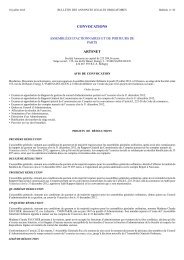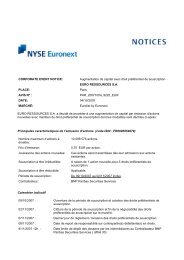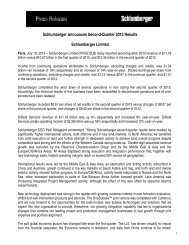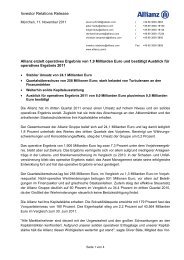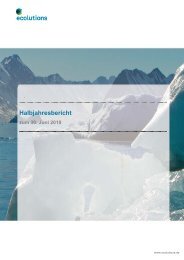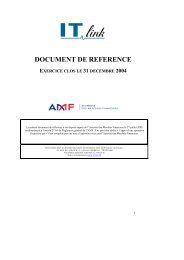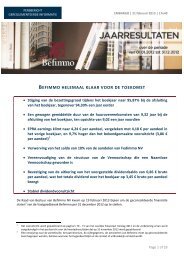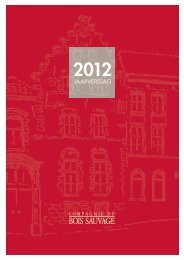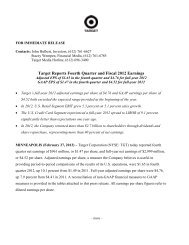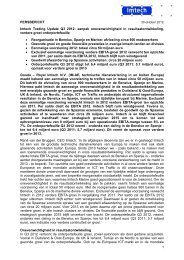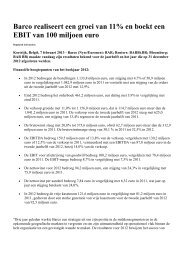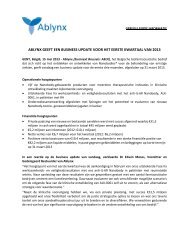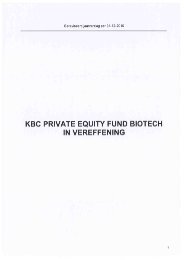2006 Annual Report
2006 Annual Report
2006 Annual Report
Create successful ePaper yourself
Turn your PDF publications into a flip-book with our unique Google optimized e-Paper software.
Our guarantees of $268 million listed in the preceding table<br />
include $43 million for guarantees that will not be in effect until<br />
the underlying properties open and we begin to operate the properties.<br />
Guarantees not in effect are comprised of $5 million of debt<br />
service guarantees and $38 million of operating profit guarantees.<br />
The guarantees of $268 million in the preceding table do not<br />
include $283 million of guarantees related to Senior Living<br />
Services lease obligations and lifecare bonds for which we are<br />
secondarily liable. Sunrise Senior Living, Inc. (“Sunrise”) is the primary<br />
obligor of the leases and a portion of the lifecare bonds,<br />
and CNL Retirement Properties, Inc. (“CNL”) is the primary obligor<br />
of the remainder of the lifecare bonds. Prior to the sale of the<br />
Senior Living Services business in 2003, these preexisting guarantees<br />
were guarantees by the Company of obligations of consolidated<br />
Senior Living Services subsidiaries. Sunrise and CNL have<br />
indemnified us for any guarantee fundings we may be called on<br />
to make in connection with these lease obligations and lifecare<br />
bonds. We do not expect to fund under the guarantees.<br />
The table also does not include lease obligations for which<br />
we became secondarily liable when we acquired the<br />
Renaissance Hotel Group N.V. in 1997, consisting of annual rent<br />
payments of approximately $22 million and total remaining rent<br />
payments through the initial term of approximately $218 million.<br />
CTF has made available €35 million in cash collateral in the<br />
event that we are required to fund under such guarantees. As<br />
CTF obtains releases from the landlords and these hotels exit<br />
the system, our contingent liability exposure of approximately<br />
$218 million will decline. Since we assumed these guarantees,<br />
we have not funded any amounts, and we do not expect to fund<br />
any amounts under these guarantees in the future.<br />
In addition to the guarantees described above, in conjunction<br />
with financing obtained for specific projects or properties owned<br />
by joint ventures in which we are a party, we may provide industry<br />
standard indemnifications to the lender for loss, liability or<br />
damage occurring as a result of the actions of the other joint<br />
venture owner or our own actions. Furthermore, in addition to<br />
the project completion guarantees noted in the preceding table,<br />
we have provided a project completion guarantee to a lender for<br />
a project with an estimated aggregate total cost of $524 million.<br />
Payments for cost overruns for this project will be satisfied by the<br />
joint venture via contributions from the partners, and we are<br />
liable on a several basis with our partners in an amount equal to<br />
our pro rata ownership in the joint venture which is 34 percent.<br />
We do not expect to fund under this guarantee.<br />
Commitments and Letters of Credit<br />
In addition to the guarantees noted previously, as of year-end<br />
<strong>2006</strong>, we had extended approximately $11 million of loan commitments<br />
to owners of lodging properties, under which we<br />
expect to fund approximately $5 million by year-end 2007. We<br />
do not expect to fund the remaining $6 million of commitments,<br />
which expire as follows: $1 million within one year; $1 million in<br />
three to four years; and $4 million after five years. At year-end<br />
<strong>2006</strong>, we also have commitments to invest up to $31 million of<br />
equity for minority interests in partnerships that plan to purchase<br />
both North American full-service and limited-service<br />
hotels, which expire as follows: $5 million within one year;<br />
$21 million in one to two years; and $5 million after five years.<br />
At year-end <strong>2006</strong>, we also had $108 million of letters of credit<br />
outstanding on our behalf, the majority of which related to our<br />
self-insurance programs. Surety bonds issued on our behalf at<br />
58 | MARRIOTT INTERNATIONAL, INC. <strong>2006</strong><br />
year-end <strong>2006</strong>, totaled $640 million, the majority of which were<br />
requested by federal, state or local governments related to our<br />
lodging operations, including our Timeshare segment and selfinsurance<br />
programs.<br />
Synthetic Fuel<br />
The tax credits available under the Internal Revenue Code for<br />
the production and sale of synthetic fuels were established by<br />
Congress to encourage the development of alternative domestic<br />
energy sources. Congress deemed that the incentives provided<br />
by the tax credits would not be necessary if the price of oil<br />
increased beyond certain thresholds as prices would then provide<br />
a more natural market for these alternative fuels. As a result,<br />
the tax credits available under the Internal Revenue Code for the<br />
production and sale of synthetic fuel in any given calendar year<br />
are phased out if the Reference Price of a barrel of oil for that<br />
year falls within a specified range. The Reference Price of a barrel<br />
of oil is an estimate of the annual average wellhead price per<br />
barrel of domestic crude oil and is determined for each calendar<br />
year by the Secretary of the Treasury by April 1 of the following<br />
year. In 2004 and 2005, the Reference Price was roughly equal to<br />
89 percent of the average price in those years of the benchmark<br />
NYMEX futures contract for a barrel of light, sweet crude oil. The<br />
price range within which the credit is phased out was set in<br />
1980 and is adjusted annually for inflation. In 2005, the<br />
Reference Price phase-out range was $53.20 to $66.79. Because<br />
the Reference Price of a barrel of oil for 2005 was below that<br />
range, at $50.26, there was no reduction of the tax credits available<br />
for synthetic fuel produced and sold in 2005. Assuming a<br />
2 percent inflation adjustment factor for <strong>2006</strong> and assuming<br />
that the ratio of the Reference Price to the average price of the<br />
benchmark NYMEX futures contract remains approximately the<br />
same in <strong>2006</strong> as it was in 2005, we currently estimate that there<br />
was a 39 percent reduction of the tax credits available for synthetic<br />
fuel produced and sold in <strong>2006</strong>.<br />
We cannot predict with any accuracy the future price of a<br />
barrel of oil. As noted in Footnote No. 2,“Synthetic Fuel,” earlier<br />
in this report, we suspended synthetic fuel production twice in<br />
<strong>2006</strong> for varying lengths of time in response to high oil prices. If<br />
the Reference Price of a barrel of oil in 2007 exceeds the applicable<br />
phase-out threshold, the tax credits generated by our synthetic<br />
fuel facilities in 2007 could be reduced or eliminated,<br />
which would have a negative impact on our results of operations.<br />
Late in <strong>2006</strong> and early in 2007, we entered into hedge<br />
agreements to minimize operating losses that could occur if<br />
more than a majority of the tax credits are phased out in 2007.<br />
See Footnote No. 2,“Synthetic Fuel,” earlier in this report, for<br />
additional information related to the synthetic fuel operations,<br />
including information related to the cessation of synthetic fuel<br />
production permanently at the end of 2007.<br />
Investment in Leveraged Lease<br />
At year-end <strong>2006</strong>, we had a $23 million investment in an aircraft<br />
leveraged lease with Delta Air Lines, Inc. (“Delta”) which we<br />
acquired in 1994.The gross investment is comprised of rentals<br />
receivable and the residual value of the aircraft offset by<br />
unearned income. On September 14, 2005, Delta filed for bankruptcy<br />
protection under Chapter 11 of the U.S. Bankruptcy Code<br />
and informed us that it wished to restructure the lease. As a result,<br />
we believe our investment was impaired, and have recorded pretax<br />
charges of approximately $18 million through <strong>2006</strong>.



